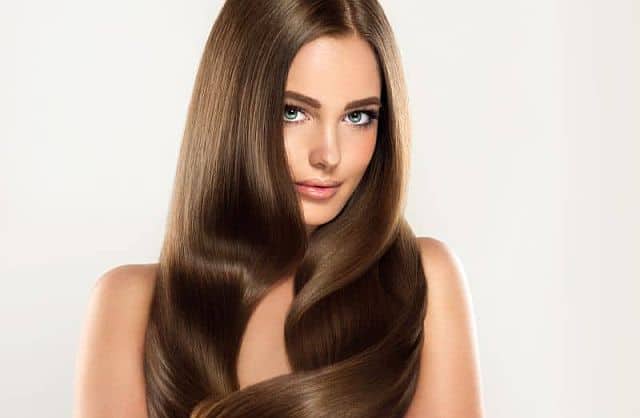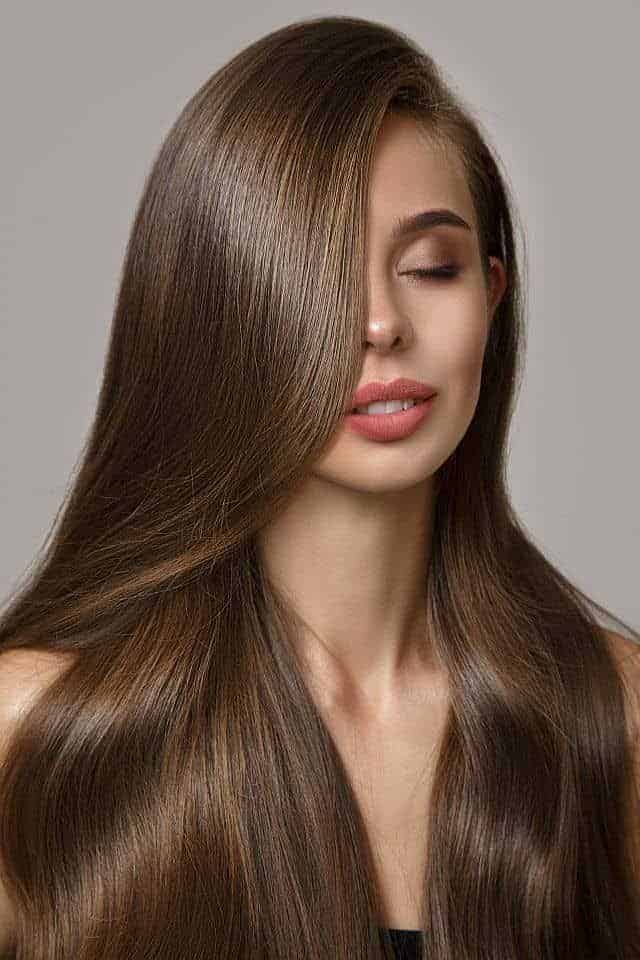Last Updated on January 2, 2023 by Gaga
Shiny hair is a sign that your locks are healthy, which is what the majority of people hope to achieve. When your hair is healthy, the cuticles tightly cover the hair shaft, making the surface of your hair smooth. A smooth, healthy strand of hair reflects light like a mirror, giving it a shiny appearance.
Chemical treatments, excessive heat, chlorinated water, and extreme environmental conditions can cause hair damage, disturbing the naturally smooth cuticle layer and leaving your strands looking frizzy, dull, and lifeless. Your hair color may also lose its vibrancy and fade faster. Such over-processed and damaged hair has a rough and porous surface meaning it can’t reflect light.
Fortunately, there are hair treatments that can restore shine and make your locks look fabulous again! Hair glosses and hair glazes are the best solutions for overly porous lackluster hair.
These shine-enhancing treatments are gaining popularity because of their ability to smooth the hair surface, giving your hair the desired luster. Both treatments are pretty easy to apply, and can be used on any hair type, including virgin, color-treated, and highlighted hair.

Hair Gloss vs. Hair Glaze Treatment
These two treatments differ from one another in the way they work. Hair glosses work by penetrating the hair shaft and sealing the cuticles. Hair glaze products simply coat your strands and just sit on the surface. Another difference is how long the treatment will stay in your hair before being washed out. But let’s look at it a little closer.
Hair gloss usually contains peroxide in its formula. The peroxide can lift the cuticle and penetrate the hair shaft, allowing for the depositing of color pigments inside the hair shaft. Hair glossing treatment can change hair color by a full shade with effects lasting about 4-6 weeks.
Hair glaze is a temporary shine treatment, which doesn’t contain ammonia or peroxide and cannot, therefore, open the cuticle. This treatment gently coats your strands with shine or/and semi-permanent color. Consequently, the effects are considerably more short-lived compared to hair gloss and last only a week or two.
Both treatments give a similar result – glowing and healthy-looking hair. Although hair color experts consider them to be two separate types of products, manufacturing companies often use the terms “hair gloss” and “hair glaze” interchangeably. What’s even more confusing is that many hair dye manufacturers add the word “gloss” to their products for marketing purposes.
Let’s Try to Simplify It
At this point, trying to make a clear distinction between hair gloss and hair glaze treatment is useless and can even add to the confusion. So, in this article, we are going to talk about two formulas regardless of the name on the packaging.
- The first is a mild, short-lived formula that just coats the hair shaft.
- The second formula penetrates the hair shaft and lasts up to six weeks.
Both formulas are available in two options: clear and tinted.
Before you decide between these options, you should talk to your stylist about desired results. Also, ask questions about the product they are going to use.
If you decide to do a glossing treatment at home, make sure to carefully read the directions for use. Take time to learn about the product and the results you can expect.
Clear vs. Tinted Hair Gloss/Glaze
As we already mention, hair shine treatments are available in two versions – clear and tinted. Both versions will provide you with glamorous shiny hair and help extend the life of your current hair color.
Colored glossing/glazing treatments work to enhance and maintain the underlying color and add shine.
Clear glossing/glazing products do not contain color, which makes them suitable for every shade of natural or color-treated hair. Clear glosses/glazes seal the cuticle layer and coat the hair shaft with a transparent shine.
The Longevity of Hair Gloss and Hair Glaze Treatments
The stronger formulas of hair shine treatment penetrate the hair shaft and produce more lasting results. The effects last for three to six weeks. The longevity may vary among brands and whether you have received the treatment in a salon or have done it yourself.
The milder formulas are a short-term solution, lasting one to two weeks since they only coat hair strands. Both formulas fade away with normal hair washing.

Benefits of Hair Shine Treatments
- Shine-enhancing treatments are relatively mild and less damaging to your hair and scalp compared to regular dyes. A shine treatment provides intense conditioning for stressed, dull, and lifeless hair. It helps to temporarily fix the damage, prevents flyaway hair, and minimizes the appearance of frizz. To maintain the results, use sulfate-free products that are designed for colored hair.
- Both treatments protect the color from washing out fast and stretch out the time between color appointments. Shine treatment helps seal freshly applied hair color, creating a protective film that helps reduce fading. It also helps revive your color once it starts to fade.
- Hair gloss/glaze treatment can fix a bad dye job. If your color has turned out a little brighter than desired, the glossing treatment can help adjust the tone.
- Gloss/glaze treatments can tone down brassy highlights and orange hues in blonde and brunette hair while eliminating yellow from grays.
- The milder formulas cover the hair shaft, leaving hair shiny, smooth to the touch, and easy to style. They cannot change the existing color, but do bring back the natural shine to hair that feels dry and dull.
- You can change your color whenever you want as shine treatments will not interfere with any type of chemical treatments you may decide to do.

Which Hair Gloss/Glaze Treatment to Choose?
The decision depends on your preferences and the specific needs of your hair.
If your hair color has started to fade, but you are not ready for the next color service, look for a gloss/glaze with color pigments to get your rich shade back. Tinted shiny treatments can provide decent color refreshment between permanent color services.
For those who are not happy with their current color, a tinted shine treatment can make subtle corrections to a previously applied color. If the color turned out a little brighter than desired, the tinted hair gloss/glaze can help adjust the tone.
If you are a brunette and want to balance out brassy highlights, look for a colored hair gloss or glaze.
If you are blonde and your hair is getting dull and brassy, go for a clear product.
Individuals with virgin hair can use the treatment to make their hair healthier-looking and shinier. Clear treatments make the natural color more beautiful due to increased light reflection.
Tinted shine treatments can be the perfect way for hair color newbies to experiment with colors without commitment.
If you want to cover your gray roots, opt for a stronger and tinted glossing product. The stronger hair glossing formula, especially the tinted one, will efficiently mask growing roots until your next salon appointment. Mild and clear formulas will not provide the full coverage of gray hair. However, they can smooth the cuticle layer and add a hint of tone to blend in a few pesky strays.
If you like your hair color (natural or dyed) and only want to add shine and softness, look for a clear gloss or glaze. A clear shine treatment will revitalize hair’s natural brilliance, soften the strands, and refresh faded lengths and ends.
If you prefer not to use chemicals on your hair, a milder formula that just coats the hair shaft is less likely to contain any harsh ingredients.
If you prefer doing hair shiny treatment at home, the mild and clear formulas are quicker and easier to apply.

Gaga is a blogger and founder of the Softer Hair website. She often says that insomnia is to blame for her first blogging attempts. Being the night owl, she hated the morning alarm. She left her office job and returned to what she loved most - writing.

